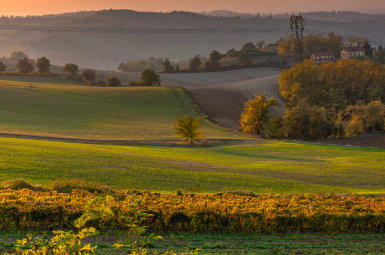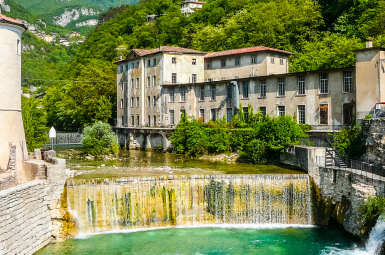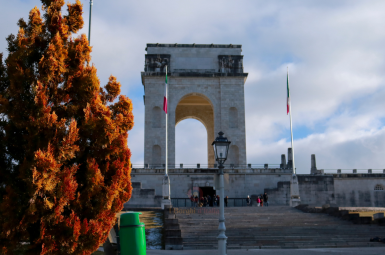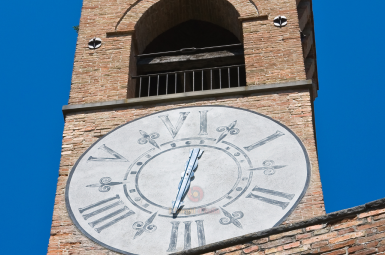
Cividale del Friuli
Il Borgo di Cividale del Friuli
Il Tempietto Longobardo: Il Gioiello UNESCO
Il cuore pulsante di questa eredità è il Tempietto Longobardo (o Oratorio di Santa Maria in Valle), l’architettura altomedievale più significativa e meglio conservata in Europa.- Unico al Mondo: All’interno del Monastero di Santa Maria in Valle, questo piccolo capolavoro risalente all’VIII secolo stupisce per la sua straordinaria decorazione a stucco e per i frammenti di affreschi. Osserva il fregio in stucco che ritrae una teoria di sante e martiri: una testimonianza di altissimo livello artistico che celebra la fusione tra l’arte classica, bizantina e la nascente cultura longobarda.
- I Longobardi in Italia: Il Tempietto, insieme ad altri resti del Complesso Episcopale, è l’emblema del sito seriale UNESCO “I Longobardi in Italia. I luoghi del potere (568-774 d.C.)“, che ha conferito a Cividale un prestigio storico e culturale mondiale.
Il Ponte del Diavolo: Leggenda e Paesaggio
Icona inconfondibile di Cividale, il Ponte del Diavolo incarna il fascino della leggenda e uno degli scorci più suggestivi del Friuli.- Lo Spettacolo Naturale: Il ponte, costruito nel XV secolo, scavalca con le sue maestose arcate il profondo orrido scavato dal fiume Natisone. La vista da qui è impagabile, con il fiume che serpeggia tra le rocce e le antiche case che si specchiano nell’acqua cristallina.
- Il Patto con il Demonio: La tradizione narra che, per costruire l’imponente opera in tempi rapidi, i cividalesi chiesero aiuto al Diavolo, promettendogli in cambio l’anima del primo che avesse attraversato il ponte. Gli astuti abitanti, però, ingannarono il maligno facendo passare per primo un animale, salvando così l’anima della città.
Oltre il Mito: Arte e Profondità
Cividale offre molto di più, invitandoti a un viaggio tra i secoli:- Il Duomo e il Museo Archeologico: Nella piazza principale, il Duomo di Santa Maria Assunta custodisce tesori come la Pala d’argento di Pellegrino II. Proprio accanto, il Museo Archeologico Nazionale espone reperti di inestimabile valore che raccontano la storia romana e l’epopea longobarda.
- L’Ipogeo Celtico: Per i più avventurosi, l’enigmatico Ipogeo Celtico, un complesso di cavità sotterranee con mascheroni scolpiti, offre un tuffo in un passato ancora avvolto nel mistero sulla sua funzione originaria (tomba celtica, carcere o luogo di culto?).
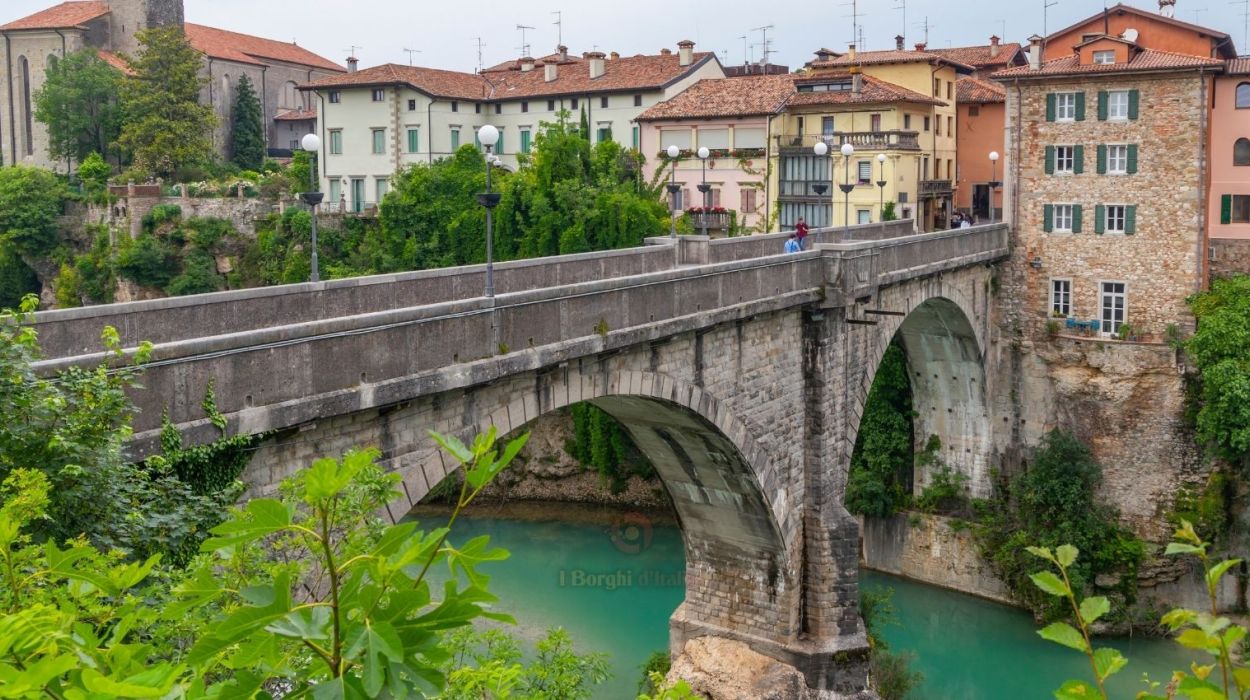
Il Borgo d’Italia
tutto da scoprire ed esplorare
Monumenti
Cividale del Friuli: Cronache di Pietra tra Storia e Mistero
Antica Forum Iulii e prima capitale del Ducato Longobardo in Italia, Cividale del Friuli è un palinsesto storico che celebra tremila anni di civiltà. Riconosciuta dall’UNESCO come sito Patrimonio Mondiale dell’Umanità, la città ducale custodisce monumenti di inestimabile valore, che narrano la transizione dall’epoca romana al Medioevo, in un equilibrio perfetto tra maestosità architettonica e arte sacra.
Il Tempietto Longobardo: Capolavoro Tardo Antico
Nel cuore della Gastaldaga si cela il Tempietto Longobardo, il più significativo e meglio conservato esempio di architettura alto-medievale in Occidente. Sorto nell’VIII secolo come cappella palatina del Duca, questo gioiello fa parte del complesso del Monastero di Santa Maria in Valle.
- Architettura e Decorazione: L’edificio si distingue per la sua pianta asimmetrica e l’eccezionale apparato decorativo. Sei figure di Sante in stucco, scolpite in uno stile che preannuncia il “Rinascimento Longobardo”, dominano l’arco trionfale, testimoniando la fusione tra influenze classiche, bizantine e germaniche. Il Tempietto non è solo un monumento, ma una finestra unica sull’arte e sulla spiritualità dell’epoca.
Il Complesso del Duomo e il Tesoro Longobardo
Affacciato sulla piazza principale, il Duomo di Santa Maria Assunta rappresenta il fulcro religioso della città. Ricostruito in stile rinascimentale a partire dal XV secolo, l’imponente edificio in pietra custodisce un tesoro inestimabile: il Museo Cristiano.
- L’Altare di Ratchis: All’interno del Museo, è conservato il celebre Altare di Ratchis (VIII secolo). Scolpito per il duca Ratchis, questo blocco in pietra d’Istria è un’opera fondamentale della scultura longobarda, caratterizzata da un rilievo bidimensionale e da una potente espressione spirituale.
- Il Battistero di Callisto: Accanto all’altare, risplende il Battistero di Callisto (VIII secolo), un fonte ottagonale i cui pilastri sono decorati con iscrizioni e rilievi che celebrano la grandezza del Patriarca Callisto, simboli del potere ecclesiastico cividalese.
Il Ponte del Diavolo: Equilibrio tra Storia e Leggenda
Simbolo indiscusso di Cividale, il Ponte del Diavolo è un’ardita struttura in pietra che unisce le due sponde del Natisone. Costruito a partire dal 1442, si erge con due arcate asimmetriche, poggiando su un masso roccioso naturale al centro del letto del fiume.
- Scenario Suggestivo: Oltre all’importanza ingegneristica e storica, il ponte offre una vista mozzafiato sulla forra del Natisone, un panorama che ne amplifica il fascino misterioso. La sua stessa esistenza è avvolta da una leggenda popolare che narra di un patto siglato con il Diavolo per la sua rapida costruzione.
L’Ipogeo Celtico: Enigma Sotterraneo
Per coloro che cercano un’esperienza più misteriosa, l’Ipogeo Celtico è una serie di cavità sotterranee scavate direttamente nella roccia, con un sistema di gallerie e sale.
- Funzione Contesa: La sua origine e funzione sono oggetto di dibattito tra gli studiosi. Mentre alcuni elementi, come i mascheroni scolpiti nella parete rocciosa, suggeriscono una destinazione funeraria o rituale in epoca celtica, è probabile che le strutture siano state riutilizzate come prigioni in epoca romana e longobarda. È un viaggio suggestivo nelle viscere della terra che testimonia l’estrema antichità e complessità storica di Cividale.
Curiosità
Cividale del Friuli: Oltre la Storia, le Curiosità della Città Ducale
Cividale del Friuli, l’antica Forum Iulii che diede il nome all’intera regione, è un luogo in cui la storia millenaria si intreccia con leggende affascinanti e tradizioni uniche. Questa città, Patrimonio UNESCO per i suoi tesori longobardi, riserva sorprese e curiosità che vanno oltre i libri di storia, rendendo ogni visita un’autentica scoperta.
La Spada e l’Agnello: Riti e Misteri Longobardi
Cividale non è solo un museo a cielo aperto, ma un teatro di riti che affondano le radici nel suo glorioso passato ducale.
- La Messa dello Spadone: Ogni anno, il 6 gennaio, Cividale rivive una delle sue più singolari e suggestive tradizioni: la Messa dello Spadone. Durante questa solenne celebrazione nel Duomo, un diacono indossa un’armatura d’epoca e brandisce una lunga e antica spada, simbolo dell’autorità ducale e patriarcale. Il rito, che risale al XIV secolo, commemora il Patriarca Marquardo di Randeck ed è un’eccezionale fusione tra liturgia religiosa e simbologia militare, un unicum nel panorama europeo.
- L’Altare di Ratchis e l’Agnello: Nel Museo Cristiano, l’iconico Altare di Ratchis (VIII secolo), capolavoro della scultura longobarda, presenta un dettaglio curioso e potente. La lastra dedicata all’Adorazione dell’Agnello di Dio è caratterizzata da figure umane rappresentate con pose rigide e frontali, mentre l’Agnello, simbolo cristologico, è reso con un dinamismo quasi naturalistico. Questa enfasi sull’Agnello rispetto alle figure umane è un tratto distintivo dell’arte longobarda, che privilegia il significato simbolico e teologico sulla rappresentazione naturalistica.
Leggende Nascoste tra Fiume e Sottosuolo
Le meraviglie naturali e architettoniche di Cividale sono spesso velate da storie tramandate oralmente che ne accrescono il fascino.
- La Leggenda del Ponte del Diavolo: Il simbolo per eccellenza della città deve il suo nome, e la sua stessa esistenza, a una popolare leggenda. Si narra che i cividalesi, incapaci di costruire un ponte solido sul Natisone, invocarono il Diavolo. Egli promise di erigerlo in una sola notte in cambio dell’anima del primo che lo avrebbe attraversato. Gli abitanti, astuti, mandarono per primo un animale, beffando il Maligno e lasciandolo infuriato, ma costretto a rispettare il patto.
- Il Mistero dell’Ipogeo Celtico: Nascosto nelle viscere della roccia sotto la città, l’Ipogeo Celtico rimane un enigmatico sistema di cavità. La presenza di mascheroni scolpiti e nicchie ha fatto ipotizzare un’origine funeraria celtica, ma l’ipotesi di un suo utilizzo come prigione in epoca romana e longobarda continua ad alimentare il mistero. È un luogo che sfida la storia, un segreto custodito nel cuore di Cividale.
Natura e Tradizioni Fuori dal Centro Storico
L’identità di Cividale si estende oltre le mura, abbracciando il contesto geografico circostante.
- L’Orrido del Natisone: Il fiume Natisone non è solo lo sfondo del Ponte del Diavolo, ma è anche il creatore di uno spettacolare fenomeno naturale: l’Orrido. Le acque hanno scavato nel corso dei millenni una gola profonda e scenografica, trasformando il paesaggio in un canyon suggestivo che merita di essere esplorato per la sua bellezza selvaggia e inattesa, a pochi passi dal centro storico.
- Terra di Confine e Plurilinguismo: Cividale si trova in una zona storicamente cruciale e culturalmente ricca. È un crocevia di influenze slave, germaniche e latine. Ancora oggi, la sua area è vicina a comunità di lingua slovena, riflettendo una complessità culturale e linguistica che ha plasmato l’identità del Friuli Orientale.
Personaggi
Eroi e Menti Elette: L’Eredità Intellettuale di Cividale del Friuli
Cividale del Friuli non è solo un gioiello di architettura longobarda, ma è stata la culla di figure che hanno lasciato un segno indelebile nella storia, nella letteratura e nella cultura italiana ed europea. Dagli storici che hanno narrato le gesta di un’intera civiltà ai campioni sportivi, la città ducale vanta un patrimonio umano di rara eccellenza.
Il Cronista dell’Epoca d’Oro: Paolo Diacono
Nessun personaggio incarna lo spirito intellettuale di Cividale più di Paolo Diacono (Paulus Diaconus).
- Storico e Poeta (VIII Secolo): Nato probabilmente a Cividale (allora Forum Iulii) intorno al 720 d.C., Paolo Diacono è l’autore della “Historia Langobardorum”, l’opera storiografica fondamentale che narra le vicende del popolo Longobardo dalla sua origine fino al 744 d.C. La sua penna non si limita alla mera cronaca: è un affresco vivace e dettagliato della vita, delle guerre e delle leggi di un popolo che aveva eletto Cividale a suo primo e potente ducato in Italia.
- L’Eredità: Senza la sua meticolosa opera, gran parte della conoscenza sull’epoca longobarda sarebbe andata perduta. La sua figura è il pilastro su cui si fonda la memoria storica della città e del Friuli intero, un monumento vivente alla storiografia medievale.
Il Giurista e Beato: Contardo Ferrini
Sebbene nato a Milano, la storia di Contardo Ferrini è profondamente legata al Friuli e a Cividale, dove trascorse la sua giovinezza e si formò accademicamente.
- Giurista di Fama Internazionale (1859 – 1902): Professore di Diritto Romano nelle più prestigiose università italiane, Ferrini fu un giurista di eccezionale rigore e preparazione, ammirato per la sua vasta erudizione.
- Fede e Scienza: La sua vita fu un raro esempio di armonia tra una brillante carriera accademica e una profonda spiritualità. Proclamato Beato dalla Chiesa Cattolica, Ferrini rappresenta l’ideale del laico impegnato nella scienza e nella fede, un modello per gli studenti e gli studiosi.
L’Ombra del Maestro: Andrea Palladio
Anche se non nativo di Cividale, la città vanta una connessione illustre con il più grande architetto del Rinascimento.
- Progettista del Palazzo dei Provveditori: La tradizione, supportata da testimonianze storiche come quella di Giorgio Vasari, attribuisce ad Andrea Palladio il progetto del Palazzo dei Provveditori Veneti, l’edificio che oggi ospita il Museo Archeologico Nazionale. Nonostante le interruzioni e le modifiche in fase di costruzione, l’armonia delle proporzioni e l’eleganza delle forme sulla facciata testimoniano la chiara influenza del linguaggio palladiano, lasciando il segno di un maestro indiscusso anche in questa città ducale.
Le Figure dello Sport e della Cultura Contemporanea
Cividale ha continuato a forgiare talenti, specialmente nel mondo dello sport e dello spettacolo.
- Roberto Chiacig: Rinomato cestista italiano (nato a Cividale nel 1974), ha avuto una carriera di successo sia in Italia che in Nazionale, culminata con la vittoria della medaglia d’argento alle Olimpiadi di Atene 2004. Un simbolo della forza e della tenacia sportiva friulana.
- Vittorio Podrecca: (1883-1959), burattinaio e animatore di fama internazionale, celebre per il suo “Teatro dei Piccoli” che ha portato l’arte dei pupazzi sui palcoscenici di tutto il mondo, dimostrando il legame di Cividale anche con le arti performative e l’innovazione scenica.
Ricette Tipiche
Sapori Ducali: Le Delizie Enogastronomiche di Cividale del Friuli
Cividale del Friuli, crocevia storico tra culture latina, slava e germanica, traduce la sua complessa identità anche in cucina. Le ricette tipiche della città ducale e delle Valli del Natisone sono un patrimonio di sapori forti, genuini e sorprendenti, dove l’arte della pasticceria si fonde con la robustezza della tradizione alpina.
La Regina della Pasticceria: La Gubana
La Gubana è il dolce simbolo non solo di Cividale, ma dell’intera regione friulana. Questo capolavoro della pasticceria è il sigillo di ogni celebrazione, in particolare delle festività natalizie e pasquali.
- L’Essenza: Si presenta come una chiocciola di pasta lievitata, ricca e soffice, che racchiude un ripieno opulento e aromatico. La farcia, vera protagonista, è un concentrato di frutta secca (noci, nocciole, mandorle, uvetta, pinoli), arricchita da spezie, cacao e un generoso tocco di grappa o rum, che ne esalta il profumo inconfondibile.
- Il Rituale: La Gubana viene tradizionalmente servita a fette, spesso accompagnata e intinta in un bicchierino di Slivovitz (distillato di prugne) o altra grappa locale, intensificando l’esperienza sensoriale. È un dolce che richiede pazienza nella preparazione e viene tramandato come un vero e proprio rito familiare.
I Gemelli Dolci e Fritti: Gli Strucchi
Compagni fedeli della Gubana, gli Strucchi (o struki) sono la versione “monoporzione” e fritta (o a volte bollita) del famoso dolce. Sono un’irresistibile tentazione, perfetti da gustare passeggiando tra le vie del centro storico.
- Il Carattere: Sono piccoli fagottini di pasta, spesso simile alla pasta frolla o alla pasta da raviolo, ripieni dello stesso, ricco impasto a base di frutta secca e liquore della Gubana.
- Varietà: Ne esistono due versioni principali: gli Strucchi fritti, dorati e croccanti, e gli Strucchi lessi, più morbidi, che vengono conditi dopo la cottura con burro fuso, cannella e zucchero. Entrambi rappresentano la semplicità della tradizione, elevata da un ripieno sontuoso.
Le Armonie Salate: Frico e Cjarsons
La robustezza della cucina friulana trova il suo apice in piatti che bilanciano ingredienti semplici con sapori intensi.
- Il Frico: Pur essendo un piatto diffuso in tutto il Friuli, il Frico è un pilastro della tavola cividalese. Nato come ricetta di recupero degli scarti del formaggio, è oggi una vera e propria leccornia a base di formaggio Montasio (di diverse stagionature) fuso e cotto in padella. Esistono due varianti: il frico morbido (spesso arricchito con patate e cipolle) e il frico croccante, una cialda sottile di solo formaggio. L’accompagnamento ideale è sempre la polenta.
- I Cjarsons (o Cialzons): Questo è il piatto simbolo della Carnia, ma è profondamente radicato anche a Cividale e nelle sue valli. Sono ravioli ripieni dalla personalità complessa e sorprendente, poiché fondono il salato con il dolce. La farcia varia di famiglia in famiglia, ma spesso include ricotta, erbe spontanee, uvetta, cannella e talvolta cacao o frutta secca. Vengono serviti conditi con burro fuso, salvia e una spolverata di ricotta affumicata (o scuete fumade), creando un contrasto di sapori indimenticabile.
